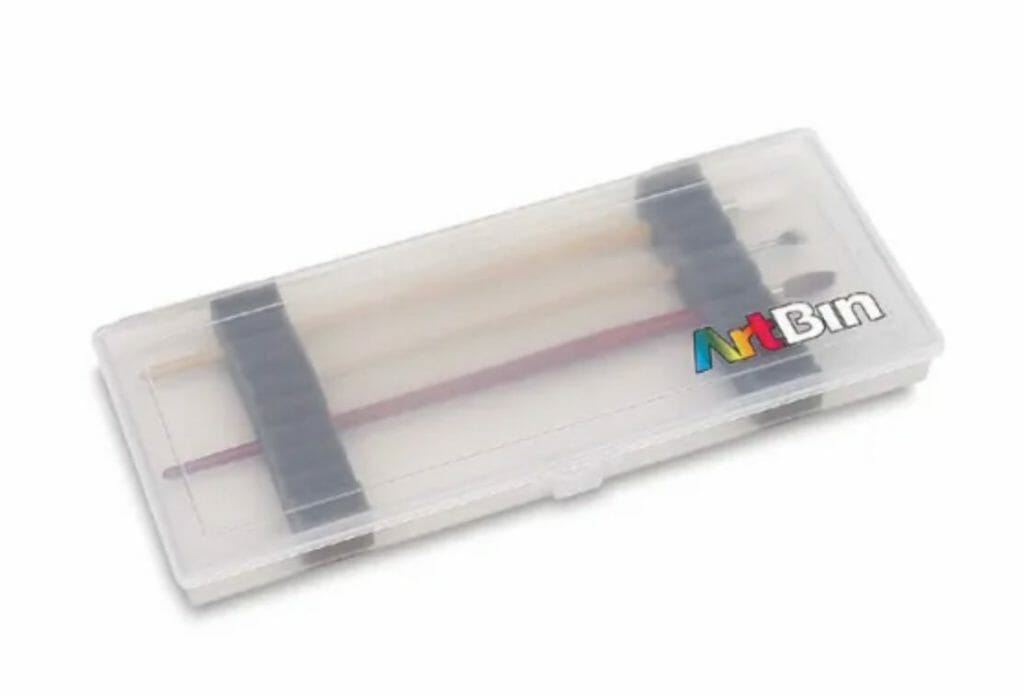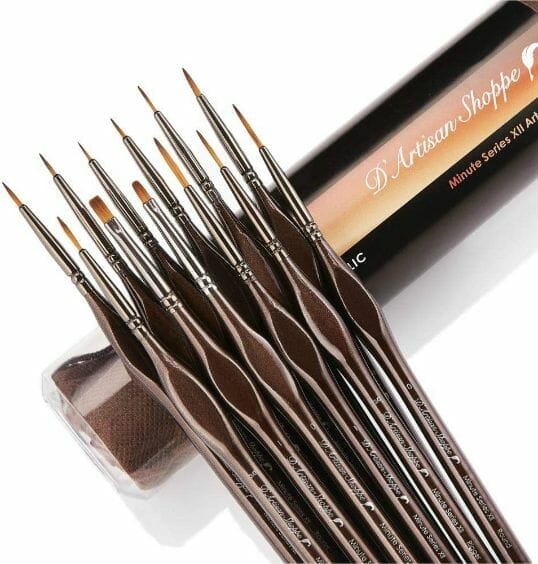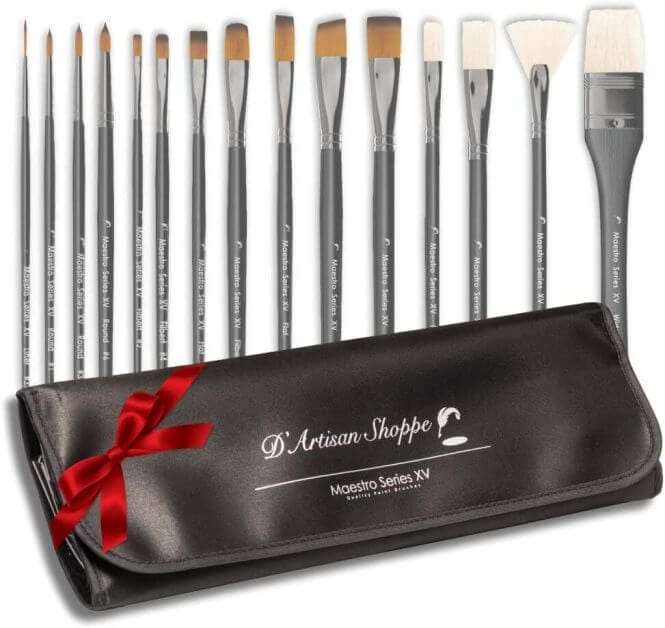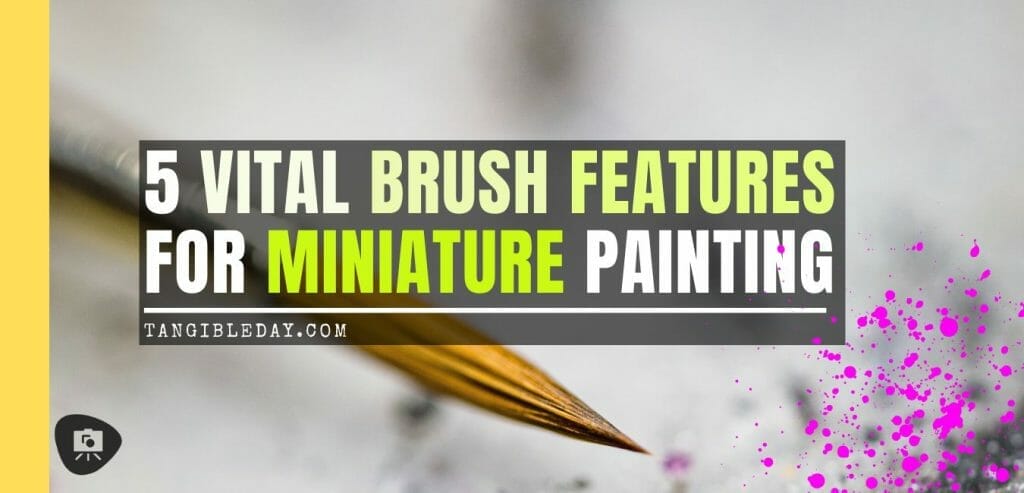A paint brush is a weapon. You wield a brush to slay “your subject”, and perhaps, often yourself (figuratively). Did you know that the act of creation is often a means of destruction, too. “To light a candle is to cast a shadow,” wrote Ursula K. Le Guin, famed fictional author and creator of the Earthsea book series. Your paintbrush is your tool for conceiving ideas, manifesting visions, and liberating emotions. Perhaps, you should know a bit more about it?
In this article, I quickly summarize 5 features about paint brushes that you should know for painting miniatures and models. If you want to learn more about the best brushes for painting miniatures, check out this guide, or for this article for budget brush alternatives to expensive sables that are great for hobbyists.
Here are 5 must-know features of paint brushes for painting miniatures and models:
- Point (tip shape)
- Paint capacity
- Bristle snap
- Bristle spring
- Paint flow
What do all these brush features mean for miniature painting? How does this help you choose the right brush for your work?
Continue reading to find out!
I own hundreds of brushes now, collected over many years. I don’t throw brushes in the trash often, favoring instead to recycle them (knowing I spent hard earned cash). What I do is convert them into dry brushes, or repurpose old brushes into workhorse tools for sculpting projects, or other abusive jobs, like glue application or mixers for harsh art media (e.g., solvents).
Yes, indeed there’s some sentiment here, and maybe I’m a closet hoarder. But, here’s what I’ve learned: every paint brush has personality, a characteristic feel, and in the ancient tradition of some pop culture, a brush may even have a soul.
RELATED: 7 REASONS WHY YOUR BRUSHES FAIL (AND HOW TO FIX THEM)
Where does the uniqueness of each paint brush come from? Well, from a physical standpoint, we can only judge a brush from what we can see and touch. Note that all of these features aren’t necessary for a good miniature painting experience or satisfying result for that matter. This is especially true if your goal is to get your miniatures painted to a tabletop standard (or battle ready state in Warhammer 40k gaming terms).
But, a little knowledge may come in handy if you’re serious about taking your miniature painting to the next level and are in the market for choosing the right brush for your workflow. Whether you’re a speed painter, a professional studio artist, or simply want to create the best art you can, you want the best tool for the job.

5 paint brush features and tips for how they useful for painting miniatures
1. Point (tip shape)
Walk into any art store and look at brushes. The point, or tip shape, is the first thing you’ll see. The brush point attribute is how well a brush comes to a fine tip when it is wet with water or paint. For the miniature painter, the point is the first feature you see that helps you decide whether the brush is for you.
The most popular brush point for painting miniatures is the “pointed round”, which comes in many sizes. The pointed round brush is a cylindrical brush shape that comes together into a cone-like, fine tip. When shopping for a pointed round paint brush, you want to make sure this shape holds true when it is wet.
Brand new pointed rounds hold their shape because they are generally coated in a post-manufacturing medium designed to keep the shape during packaging and shipping. You should test your brushes for the pointy feature by dipping the brush in water (if you can shop for your brushes in-person).
A natural hair brush with a pointed round shape will often splay apart when it dries (even the high quality brushes will do this). This is typical behavior and shouldn’t worry you. What might be a red flag is the “splitting” of the brush hairs or tip. This tendency for a brush to become a two prong brush is a defect that may or not be resolved through soap or wax conditioning by the user.
If you notice this happening to your expensive kolinsky sable brushes, then try to get a refund or exchange the brush for another. Most stores and online vendors will take care of this without question. I shop for almost all my brushes at Blick Art Materials, which have an amazing and fast customer satisfaction team available for this kind of thing. They will replace any defective brush you buy from them in a hassle free manner. I’ve done this a few times (I buy a lot of brushes).
For synthetics brushes, the pointed shape will often stay in place wet or dry. The challenge you may encounter with synthetic brushes is the tendency for the sharp tips to curl over after some use and over time.

To remedy synthetic brush curling, you can try dipping the brush in hot (close to boiling) water and quickly shaping the tips back into shape. Additionally, you can try coating the curled bristle tips in Masters brush soap and forcing the pointed shape back into place, letting the soap coating dry overnight.
Other useful brush shapes for painting miniatures include filbert and angle brushes, which can help you paint larger surfaces, blend colors, or work with thicker media, e.g., oil paints.
2. Paint capacity
Paint capacity is exactly as the name describes, the amount of paint a brush may hold. Capacity is a simple attribute of a paintbrush. Many physical factors contribute to brush paint capacity. This includes brush size, shape, and bristle material. For example, a larger brush will naturally have a larger paint capacity. Natural hair bristles have intrinsically better paint capacity than conventional synthetics (although modern synthetic bristle technology has caught up to most natural hair characteristics).
In miniature painting, you want to balance brush size with paint capacity. My recommendation is to choose the largest brush you are comfortable using and can control. By doing this, you will likewise have the largest paint capacity for the brush you’re using at all times. A well-respected pointed round brush that many miniature painters swear by include the vennerated Raphael 8404 kolinsky sable (size #1 or #2), or its slightly more affordable cousin.
Using a brush with good paint capacity should not be underestimated. You’ll paint faster, needing to reload your brush less frequently, and you may even find yourself painting details better since your paint won’t dry up on the tip of your brush. Here are other tricks for improving your ability to paint miniature details.
3. Bristle snap
Bristle snap on a paint brush is particularly important for miniature painters. Brush snap determines how quickly and easily a brush’s bristles will return to its original, straight and upright shape (lengthwise with the handle) after you bend it.
For painting minis, you want a brush that has good snap because this will give you tons of control for each and every brushstroke. Imagine a brush that doesn’t come back into its pointy tip whenever you bend it after a brushstroke. Yuck! In fact, for many advanced acrylic color blending techniques, a brush with good snap is a requirement. You can paint more precisely (and faster) with a brush that snaps back into action. The famed Winsor & Newton Series 7 brushes are renown for their excellent snap character.
Naturally, a shorter haired brush will have better snap than a long bristle paint brush. For this reason, if you’re aiming for painting fine details, choose a brush with shorter bristles over one with longer bristles. Note that shorter brush bristles have less paint capacity, so you’ll have to balance out the pros and cons of these features; snap vs. paint capacity).
For other paint brushes with awesome snap (and thus great detail painting potential), check out the “Miniaturist” DaVinci brushes or the smaller miniature sized W&N Series 7 Miniature pointed round. For freehanding, fine detailing, e.g., eyes and facial features, these short-haired brushes are hard to beat. Check out the award-winning work by Marike Reimer who uses these shorter haired brushes.
4. Bristle spring
Bristle spring may be similar to brush snap in that it contributes to maintaining brush tip shape. However, the spring character of a brush is related more to the resilience of a brush to change shape. A brush with high spring will be stiff, i.e., it won’t bend or splay out easily. Many less expensive and cheap synthetic brushes have a lot of spring and are very stiff to use. These brushes may or may not “loosen” up with use.
Good quality natural hair brushes have good spring. Though, you may find brushes called “mops” that have little, or barely-there spring (watercolor mop brushes made with squirrel hair, for example).
For some techniques like wet blending or glazing, you will find having excellent brush spring is a valuable asset. If you can apply force on a brush to push pigments around, and the brush keeps its shape, you will have a lot more control over your paint application. You can sweep and push paint where you want it to go.
Raphael 8404’s are great brushes for acrylic color blending, because they have great paint capacity and spring. I have two comparator examples of the Raphael 8404 brush with a cheaper (but excellent) sable brush in this article, and in this review of the Artis Opus S brush line.
5. Paint flow
The flow characteristic of a paint brush is how a paint behaves in the brush, and how paint leaves the brush as an artist works on a painting. For miniatures, the number one thing you want to look for with paint flow is predictability. Brushstroke after brushstroke, you want paint to consistently and reliably flow from your paint brush.
Good flow will allow you to know when and what that tiny bit of paint will do when it leaves your brush tip, especially on fine detailed surfaces you often find on miniatures and scale models.
Poor flow would mean that paint would stick in your brush (your bristles are too fine or “sticky”, which is common in some cheaper synthetic materials), or paint escapes too easily from the brush (you find this often in brushes included in children’s watercolor kits, e.g., the one with pigment cakes).
The best brushes for painting miniatures have paint flow and release characteristics that you can predict. This means a constant flow of paint from your brush to your miniature painting surface. In general, natural hair brushes have much better paint flow character than synthetics. Though, higher quality synthetic brushes, such as those made with Golden or White Taklon, will have respectable paint flow for painting miniatures.
10 Recommended Paint Brushes for Acrylic Miniature Painting
(For general miniature painting, e.g., tabletop wargaming models, start with pointed round brushes with sizes #1 or #2. See this guide for more details about best brushes for painting miniatures and tabletop gaming models)
| Sable brushes for painting miniatures | Shopping links |
|---|---|
| Blick Masterstroke (short handle) | Price on Blick Art Materials (size 0, 1, 2) |
| Rosemary & Co. Series 33 | Price on Rosemary & Co |
| Army Painter “Regiment” | Price on Amazon Price on Noble Knight Games |
| Loew Cornell American Painter Brushes | Price on Amazon Price on Blick Art Materials |
| Blick Studio Short Handle Synthetic Brushes | Price on Blick Art Materials |
| Winsor & Newton Artists Acrylic Brushes | Price on Amazon Price on Blick Art Materials |
| Winsor & Newton Series 7 Brushes | Price on Amazon Price on Blick Art Materials |
| Raphael 8404 Kolinsky Sable brushes | Price on Amazon Price on Blick Art Materials |
| Da Vinci Maestro series brushes | Price on Amazon Price on Blick Art Materials |
| Rosemary and Co. Series 33 brushes | Price on Amazon |
Paint Brush Holders and Organizers

RELATED: FUN & USEFUL PAINT BRUSH RESTS AND HOLDERS
Most Popular Paint Brush Set for Painting Miniatures and Models
The 12pc Minute Series XII Miniature Brushes for Fine Detailing is a great set for acrylic painting miniatures. Over my years of experience reviewing products, this brush set has been the most popular for many readers of this site. The Minute Series XII set comes with a variety of brush shapes, including chisel flat headed brushes, pointed rounds (most popular), and long haired liners that can help you with pin washing those panel lines in planes, cars, and other mechanicals. The handles have a flattened section, which I find comfortable to hold, but also useful for preventing brushes from rolling off the table. The brush set is reasonably priced and great for beginners and intermediate miniature painters. For more serious work and long-term durability, do consider the brushes recommended above.

Versatile Brush Set for Painting Miniatures
The Maestro Series XV Paint Brush Set is a 15 brush set, including 11 synthetic brushes and 4 hog hair brushes that are useful for any paint media. For those who are painting miniatures with oil paints (more about that here), you’ll be particular intrigued by this paint brush set. The hog hair brushes (see the white bristle brushes) are large brushes designed for painting with more aggressive techniques, e.g., dry brushing, over larger surface areas, which is particularly awesome for painting up wargaming terrain. The synthetic brushes come in a variety of shapes and sizes, including the all-around useful pointed round and filbert brush shapes, which you can use with acrylics or watercolor paints (which I also use for minis).

Conclusion
For me, paint brushes have always been a interesting tool in the miniature painting and modeling hobby. The sheer variety and unique feel of all the brushes I’ve used over the years never ceases to intrigue me. Like how many hammers or types of nails does a carpenter need? You would think only one kind would suffice. Nope.
I had fun writing this article. I hope you found this information helpful as you continue your search for the perfect brush. I’m always looking out for new topics to write about in the miniature and modeling hobby. Whether you’re a wargamer, a scale modeler, e.g., trains, automobiles, or simply love painting small figurines, this was written for you.
Do you have a favorite brush brand, type, or material?
Leave a comment below! Follow on Instagram, Twitter, and Facebook.



Tangible Day on YouTube (Miniatures and More!)





Blick’s online store has been out of stock for months! I want to try them out because I’ve read your articles & recommend them. I’ll keep checking, and thanks for another article!
Yeah I’ve noticed myself ! I’m sure they will restock soon. Thanks for reading! I’m glad you enjoyed it 🙂
& you always* recommend them.
Yeah, I love Blick Art. Though, I must admit I have a Blick Art store (brick and mortar) 15 minutes from my home. I can walk right into the shop and play with all the fun art materials in-person. Of course, I’ve ordered other supplies from the online website, too, as they often have sales and deals. Some of the brushes and other things I recommend you can find on Amazon or Jackson’s Art, too. Other places, like Hobby Lobby or Michaels (not sure how common they are in Europe or other places outside the US) also stock useful supplies for painting minis.
Pingback: Simple Brush Cleaning Tips and Instructions for Every Miniature Painter - Tangible Day